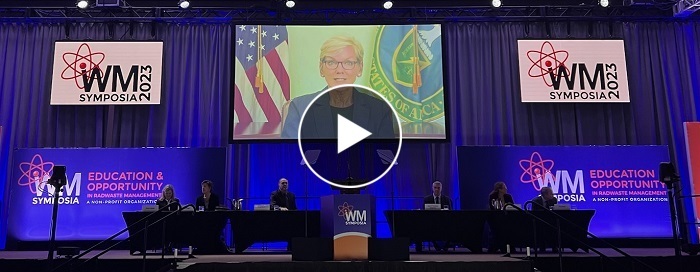 Watch this video of Energy Secretary Jennifer Granholm’s address at the 2023 Waste Management Symposia. Granholm’s remarks were recorded prior to the conference.
PHOENIX – EM has been setting the pace for a remarkable year, Energy Secretary Jennifer Granholm said in prerecorded remarks to the audience at the 2023 Waste Management Symposia on Monday.
Granholm told conference attendees EM achieved priorities across the country ahead of time and under budget, as she praised employees who made it happen.
“We crossed the finish line on key demolitions, we treated and relocated millions of gallons of waste and we deepened our engagements with local tribes and communities,” she said. “All of this is thanks to our fantastic men and women on the ground — and I’m so glad I got to meet more of you at Hanford last summer.”
EM’s success in tackling critical risks across the country has now given the program the opportunity to pivot to other issues.
“Your quick work and dogged determination make me so confident that we’re ready to embark on a new and critical phase of our mission,” Granholm said. “Because after 30 years of triaging the most pressing risks, our cleanup program is now getting ready to tackle some of its toughest challenges.”
Granholm recognized EM Senior Advisor William “Ike” White and DOE Assistant Secretary for Nuclear Energy Kathryn Huff, who were in the audience. She paid special recognition to students and young professionals attending the conference, and promoted working for DOE in scientific research, national security or clean energy.
“I’m especially excited that there are a record number of students and young professionals in the audience today — because these opportunities are for you. We need a deep and diverse bench of science, technology, engineering and math talent to get these jobs done, today and tomorrow,” she said, referencing STEM areas.
Held every year in Phoenix, Arizona, the Waste Management Symposia is an international conference that focuses on the management of radioactive waste and related issues, including the disposition of radioactive material and the decommissioning of nuclear facilities.
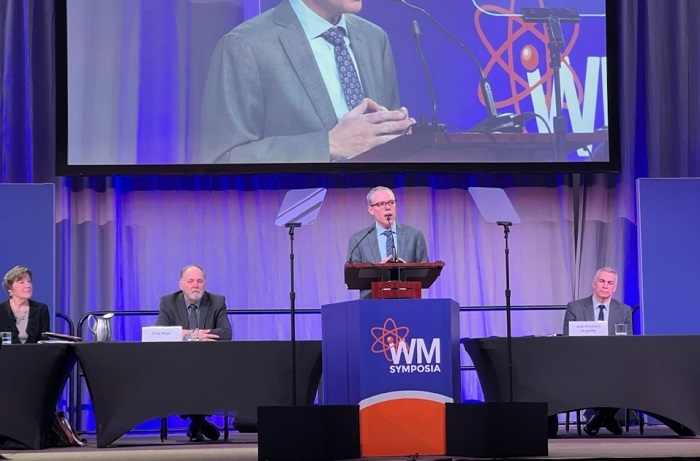 EM Senior Advisor William "Ike" White speaks to the audience at the 2023 Waste Management Symposia during his address Monday.
PHOENIX – While its mission is rooted in the environmental legacy of the past, EM is focused on possibilities for a future that holds great promise for its union workforce, industry leaders, tribal nations and communities surrounding cleanup sites, and partners around the globe, EM Senior Advisor William “Ike” White told an audience at the 2023 Waste Management Symposia on Monday.
“By partnering with local communities, prioritizing stakeholder engagement and implementing environmental justice initiatives, EM is helping to foster successful visions for the future,” he said during his address at the annual conference.
When EM is aligned with stakeholders and regulators on such visions, the cleanup program can accomplish the most.
“The tremendously successful tank waste mission at the Savannah River Site is testament to that level of alignment,” White said. “It illustrates what’s possible when we are unified in driving toward shared goals. It’s an approach that translates to each and every one of our EM sites as we pave paths to a clean, safe and vibrant future.”
In a sweeping address, White spoke about EM accomplishments last year that reduce risk and protect the environment, the program’s clean energy advancements, sustainable approaches to cleanup, contributions to national security priorities, support to tribal and community efforts to build strong economies, technology development, growing international collaborations and efforts to build a next-generation workforce.
EM hit its mark with its annual priorities scorecard last year. White highlighted some of those achievements by EM’s dedicated teams on the ground that have delivered on reducing risks and protecting the environment, including:
Looking to the next stage of cleanup activities across the complex, White said the Waste Isolation Pilot Project is central to EM’s future. Work continues on ventilation upgrades at the nation’s only repository for the disposal of transuranic waste, with commissioning of its new ventilation system slated to begin this year.
EM’s tank waste mission is also entering a new stage as the cleanup program continues the shift from construction of capabilities to treatment operations.
"At Savannah River, we are treating more tank waste than ever before," White said. "Over 5 million gallons of salt waste has gone through the site’s Salt Waste Processing Facility in just over two years of operations."
White pointed to a network of national laboratories that has developed a research and development roadmap for accelerating the Hanford Site's tank waste mission.
"The roadmap will be used to continually identify opportunities to deploy technologies that could help improve efficiency along with cost savings and schedule acceleration for Hanford’s tank waste mission," White said.
White also focused on EM's unique responsibility to carry out its mission in a manner that helps cut pollution and combat climate change, and contributes to a clean energy future.
"Last year, EM met a priority of removing 1 million pounds of an ozone-depleting chemical from the Paducah Site," he said. "This represented a benefit to the environment comparable to reducing greenhouse gas emissions by taking about 10,000 vehicles off the road in a year."
EM is a place where you can not only protect the environment but also be part of the clean energy revolution.
“We’re hiring,” White said, adding that EM is increasing efforts to foster, build and maintain a next-generation workforce with job opportunities that can build strong futures.
“To those of you still in school or just starting out, if you are interested in being part of the world’s largest environmental cleanup effort or in being part of the clean energy revolution, EM is a place where you can do that,” he said.
-Contributors: Kyle Hendrix, David Sheeley
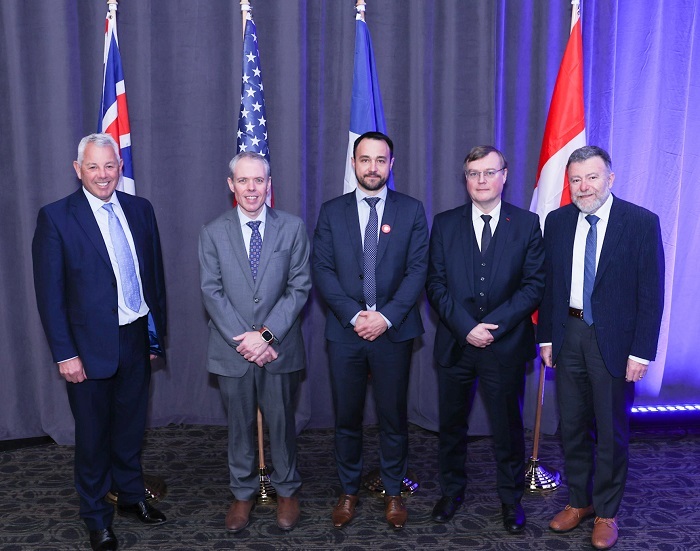 EM Senior Advisor William “Ike” White and officials from the United Kingdom, France and Canada issued a joint statement today at the 2023 Waste Management Symposia to affirm their commitment to continue their longstanding collaboration of cleanup of nuclear legacy sites. From left are Alan Cumming, Group Chief Operations and Performance Improvement, United Kingdom’s Nuclear Decommissioning Authority; White; Christophe Oudot, Director, French Alternative Energies and Atomic Energy Commission; Pierre-Marie Abadie, CEO, French National Radioactive Waste Management Agency; and Fred Dermarkar, CEO, Authority, Atomic Energy of Canada Limited.
PHOENIX – EM Senior Advisor William “Ike” White joined leaders from the United Kingdom, Canada and France at the 2023 Waste Management Symposia to issue a joint statement today declaring their commitment to continue building their longstanding collaboration of cleanup of nuclear legacy sites.
The statement affirms their dedication to continue their collaboration on the successful decommissioning and remediation of legacy nuclear sites and the safe management of radioactive waste to ensure the protection of present and future generations and the environment.
White and officials from the United Kingdom’s Nuclear Decommissioning Authority, Atomic Energy of Canada Limited, the French Alternative Energies and Atomic Energy Commission and the French National Radioactive Waste Management Agency issued the multilateral statement.
The need for safe, sustainable and economically viable site cleanup is common to many countries. International partnerships and the mutual exchange of best practices, lessons learned and innovative technologies and approaches are critical to the parties’ decisions and collective success.
The parties are proud of their collaborative efforts over the past three decades and look forward to a continued positive and productive working relationship in the future.
Read the full statement here.
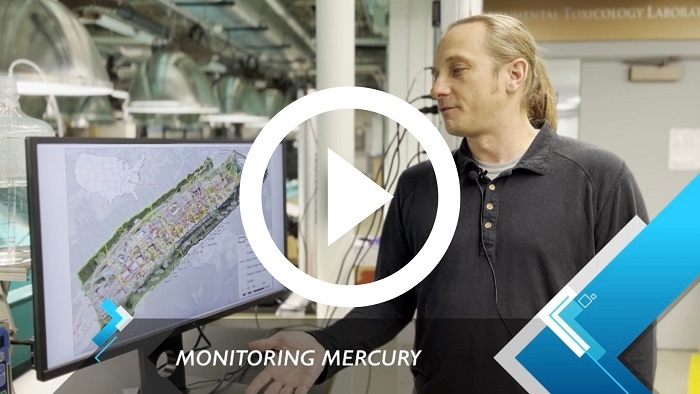 Some of the world’s leading researchers and experts on mercury contamination work at Oak Ridge National Laboratory, and they are partnering with the Oak Ridge Office of Environmental Management on solutions that can be used locally and elsewhere in the U.S. and other countries. Watch this video to learn more about these top researchers and their partnership with EM.
OAK RIDGE, Tenn. – Addressing mercury contamination at the Y-12 National Security Complex is one of the Oak Ridge Office of Environmental Management’s (OREM) top priorities.
Fortunately, Oak Ridge is home to some of the world’s foremost researchers and experts on the topic, and they are partnering with OREM on solutions that can be used locally and beyond in the U.S. and other countries.
Watch here to learn more about these top researchers and their partnership with EM.
Large amounts of mercury were used for operations at Y-12 in the 1950s and 1960s. During that time, it entered buildings, soil and the nearby Upper East Fork Poplar Creek. Presently, OREM is investing in research and infrastructure that will advance cleanup targeting the complex element.
"Mercury is a really interesting element," says Teresa Mathews, senior scientist and group leader for Biodiversity and Ecosystem Health at Oak Ridge National Laboratory (ORNL).
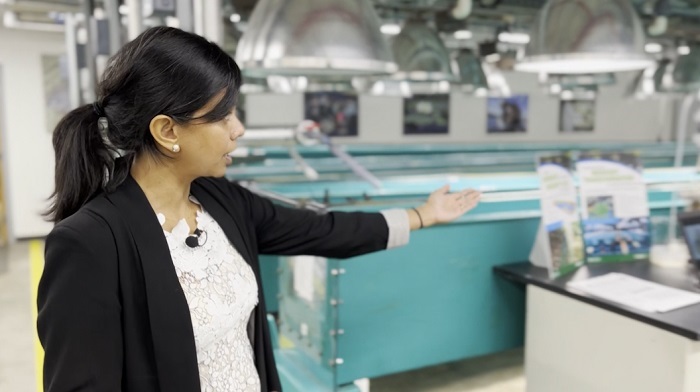 Teresa Mathews, senior scientist and group leader for Biodiversity and Ecosystem Health at Oak Ridge National Laboratory, explains how her team is working to better understand how mercury moves and changes in the environment. That research is helping develop models and create technologies that will aid EM’s cleanup at Oak Ridge and elsewhere.
Among its many unique attributes, mercury is the only metal that is liquid at room temperature. It also biomagnifies, meaning it becomes more concentrated as it moves up the food chain. That can present environmental and health risks, and it’s also why researchers are consistently testing levels in water and fish.
Once mercury is in the environment, it’s tough to get rid of it.
"Some of these properties that make it so interesting to use actually make it very difficult to remove from the environment," said Mathews.
Researchers at ORNL’s Aquatic Ecology Lab are studying how mercury flows and changes in the environment and waterways. To track mercury, scientists first had to map out the waterways.
"We had to develop a very specific understanding of where are the hotspots of mercury in the system, how is mercury flowing, what are the pathways for flow," said Mathews.
Their research is leading to technologies that can immobilize this slippery and elusive element to keep it from dispersing in the environment. Part of that plan was sending out sorbents, or materials that can absorb mercury in the environment.
A long-term study is underway. The sorbents were deployed, and researchers are studying which materials have the highest effectiveness after a year.
 Oak Ridge National Laboratory researchers have deployed sorbents, which are materials that can absorb mercury in the environment. This technology can immobilize this slippery and elusive element before it disperses into the environment.
ORNL has assembled a diverse team to make headway on technology development, modeling and research that will lead to advances in Oak Ridge’s cleanup. With mercury advisories for fish in all 50 states, the work will also be beneficial nationwide.
"We can't just have one set of expertise,” said Mathews. “We really need to be leveraging on the expertise of many diverse fields and that is the strength of working at a national lab.”
Mapping the water flow, tracking mercury and developing models takes all sorts of experts from chemists to ecologists to climatologists and more.
Together, they are working to better understand how mercury moves and changes in the environment. Equipped with that knowledge, OREM will be able to use the right technology to control the element and eliminate it from the environment to keep Oak Ridge safe.
OREM is constructing its Mercury Treatment Facility at Y-12. When operational, it will allow crews to address the largest sources of mercury at Y-12, while helping prevent it from entering the East Fork Poplar Creek and traveling offsite. The facility is designed to treat up to 3,000 gallons of water per minute and includes a 2 million-gallon storage tank to collect stormwater.
-Contributor: Summer Dashe, Ben Williams
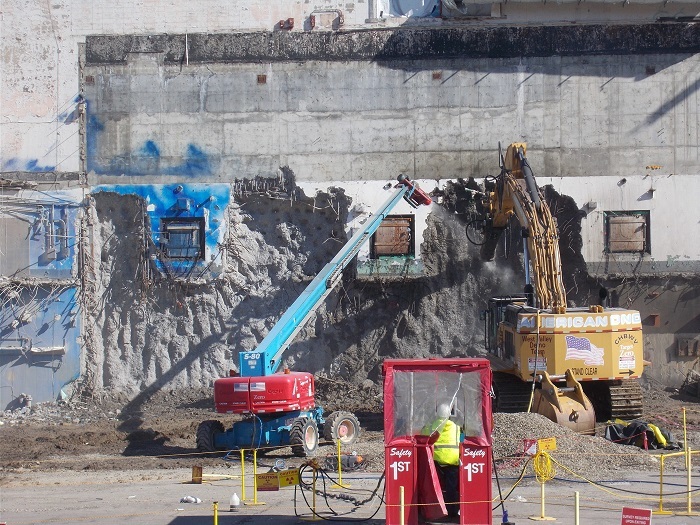 Workers take down a portion of a 5-foot-thick concrete wall of the Chemical Process Cell on the west side of the Main Plant Process Building at the West Valley Demonstration Project. The controlled demolition began in September.
WEST VALLEY, N.Y. – EM and its cleanup contractor at the West Valley Demonstration Project have safely completed demolition of seven areas of the Main Plant Process Building after launching the project early last fall.
Crews with CH2M HILL BWXT West Valley (CHBWV) have torn down a chemical extraction room, three extraction cells and other portions of the facility in compliance with local, state and federal regulations.
EM began the controlled demolition project on Sept. 21, fulfilling an EM 2022 priority. West Valley crews are now working toward carrying out an EM 2023 priority: dispose of 9,000 tons of Main Plant demolition waste.
EM officials attributed the successful demolition progress to extensive planning and preparation, an experienced workforce and their adherence to lessons learned.
“Safety comes down to planning and preparation for any work, big or small,” EM West Valley Main Plant Project Director Stephen Bousquet said. “We have deployed extensive measures, robust work controls and best practices into this project to ensure the safety of the workforce, community and surrounding environment.
Planning for the project began in 2014 with a multidisciplinary team that arranged the Main Plant into distinct areas to help determine radiological contamination levels and assess hazards. The team identified over 80 areas to be reviewed for size, history, known contamination levels, structural integrity and other factors that could affect the demolition.
Team members evaluated those areas of the Main Plant and verified their conditions. CHBWV’s radiation engineering group performed calculations to determine the rate and sequence the plant could be safely and compliantly demolished. Workers removed pipes, vessels and equipment. They also decontaminated, painted and sealed rooms as required.
Employees identified more than 120 items that needed to be removed under special instructions to control potential contamination at its source. Special containers for such items were designed, manufactured and shipped to the site.
“The deconstruction is going well, and our controls continue to keep contamination at its source,” CHBWV Facility Disposition Manager Tom Dogal said. “This result is the combination of teamwork and communication that helped create a comprehensive and unified plan to safely take down the Main Plant.”
Dogal added that he values the continuous feedback from employees to further enhance processes, procedures and work instruction packages for improved safety and productivity.
The Main Plant is one of the last remaining major facilities at West Valley. Its successful demolition will further reduce environmental risks and position the site for the next phase in cleanup. The demolition is expected to take approximately 30 months to complete.
The five-story, 35,100-square-foot, reinforced-concrete structure operated as a commercial reprocessing facility to recover reusable plutonium and uranium from spent nuclear reactor fuel. It ceased operations in 1972.
-Contributor: Joseph Pillittere
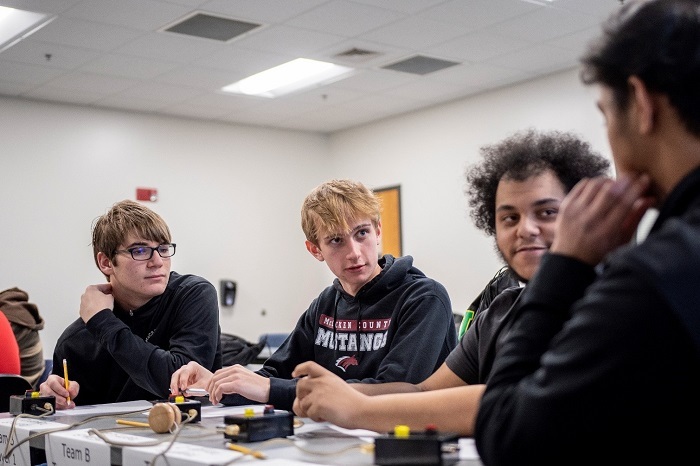 McCracken County High School students, from left, Colin McCurren, Garret Greenwell, Cole Cannon and Manav Shah consult with one another to answer questions during Friday’s DOE West Kentucky Regional Science Bowl.
PADUCAH, Ky. – McCracken County High School won this year’s DOE West Kentucky Regional Science Bowl on Friday, the culmination of months of planning by volunteers and coaches for an event touted as the region’s most prominent science competition for high school students.
The five-member team will compete in DOE’s National Science Bowl finals from April 27 to May 1 in Washington, D.C. Read about the West Kentucky Regional Science Bowl for middle school students here.
“Congratulations to this year’s winner. This event provides an excellent opportunity for students in our region to participate in a first-class competition,” Portsmouth/Paducah Project Office (PPPO) Manager Joel Bradburne said. “Our Paducah staff and contractors invest numerous hours to deliver a platform that showcases the gifted students in the Paducah community.”
 McCracken County High School won the DOE West Kentucky Regional Science Bowl. Pictured from left are EM Acting Paducah Site Lead April Ladd, Garret Greenwell, Cole Cannon, Manav Shah, Colin McCurren and McCracken County High School coach Matthew Shelton. Not pictured: Owen Cody.
The regional tournament is a quick-recall, fast-paced, question-and-answer contest. During the competition, high school students are quizzed on their knowledge of biology, chemistry, Earth and space, energy, mathematics and physics.
Calloway County High School finished second and Graves County High School took third place in the regional contest.
“The last three years have been filled with uncertainties and challenges. I’m proud of my team for the time and effort put into this year’s event. Without their hard work and determination, our win would not have been possible,” McCracken County High School coach Matthew Shelton said. “A special thanks to DOE for their continued support of this event.”
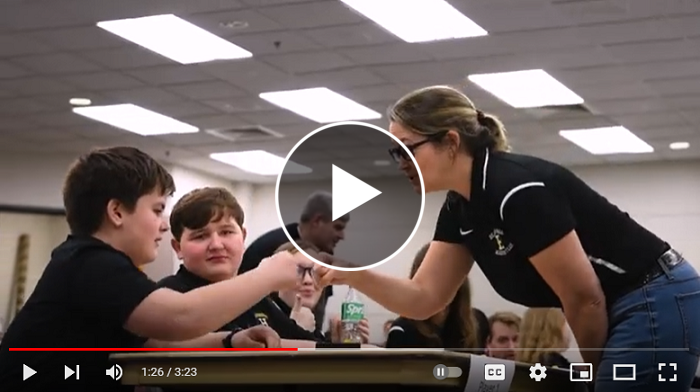 SCIENCE BOWL VIDEO: Watch this video about the DOE West Kentucky Regional Science Bowl middle school and high school competitions.
 Calloway County High School took second place in the DOE West Kentucky Regional Science Bowl. Pictured from left are EM Acting Paducah Site Lead April Ladd, Aary Patel, Ethan Cain, Isaac Martin, Elizabeth Lanier, Amber Wu and Calloway County High School coach Erica Gray.
 Graves County High School took third place in the DOE West Kentucky Regional Science Bowl. Pictured from left are Graves County High School coach Samantha Sims, Riley Ward, Lucy Baldwin, Jonathan Woods, Gracie Colley, Graves County High School coach Kait Crowe and EM Acting Paducah Site Lead April Ladd.
Also competing in this year’s regional match were Ballard Memorial, Livingston Central, Marshall County, Owensboro and Paducah Tilghman high schools in Kentucky; and Cairo Junior/Senior and Massac County high schools in Illinois.
The first place high school and middle school teams in the regional tournament will receive $1,500 for their schools.
The regional event is sponsored and organized by PPPO employees and contractors. More than 50 volunteers serve as moderators, judges, technical advisors and scorekeepers.
DOE’s Office of Science manages the National Science Bowl finals competition. Each year, more than 14,000 students from across the country compete in the national competition. Since the event began 32 years ago, more than 330,000 students have competed. More information is available here.
-Contributors: Dylan Nichols, Jessica Vasseur
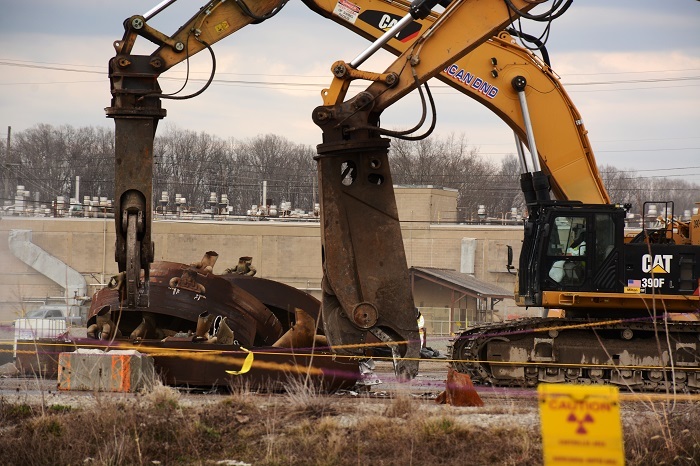 Excavators make quick work of shearing coolers from the X-333 Process Building at the Portsmouth Site.
PIKE COUNTY, Ohio – Workers are moving nearly 5,000 tons of equipment from the X-333 Process Building to a demolition pad where the X-326 Process Building once stood at EM’s Portsmouth Site.
On the north end of the pad, crews are downsizing X-326 building remnants for disposal after taking down the two-story facility that covered 56 acres under roof last year — the site’s most significant cleanup milestone to date. Just south of there, workers will shear more than 600 coolers from X-333 to meet requirements for disposition at the site’s Onsite Waste Disposal Facility (OSWDF).
All of these moving parts have required significant coordination, including approval from the Ohio Environmental Protection Agency before components could be moved and sheared. Crews from the X-333 and X-326 facilities, as well as safety, waste management, environmental remediation and radiation protection personnel, have worked together to make this happen.
“We are very proud of our workforce,” EM Portsmouth/Paducah Project Office Federal Project Director Jud Lilly said. “They took on the complicated task of removing, transporting and then shearing the first coolers from the X-333 facility, and did it safely.”
 Each cooler from the X-333 Process Building is taken to a demolition pad onsite for shearing prior to disposal.
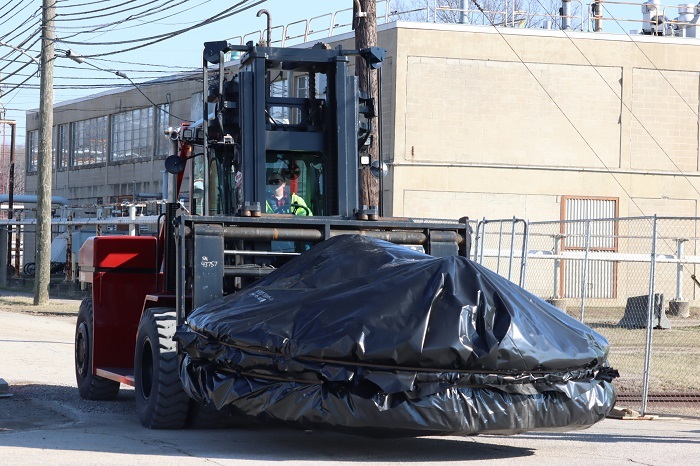 Crews removed the first cooler from the X-333 Process Building at the Portsmouth Site in February.
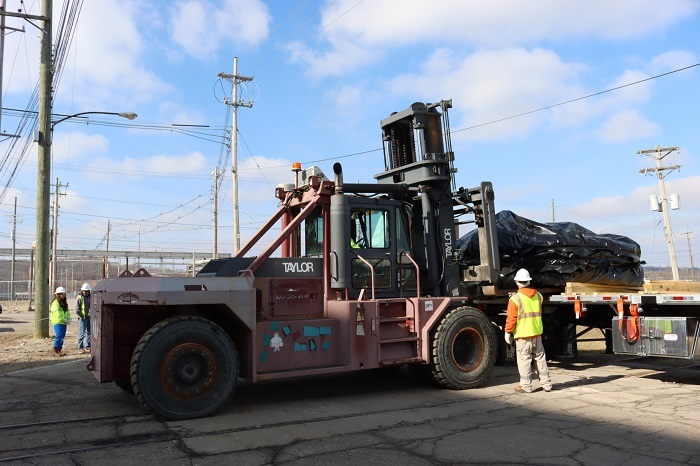 Coolers from the X-333 Process Building are transported by flatbed truck to a demolition pad where the X-326 Process Building once stood.
The X-333 crews have been staging coolers in and around the facility for the past month, wrapping them in heavy plastic for transfer to the downsizing location. Each cooler weighs more than 10,000 pounds and three are loaded onto a semi tractor-trailer for each trip to the X-326 pad. A large forklift unloads the truck and places the coolers onto cement slabs before another forklift moves each cooler to the pad for downsizing.
“Most of the Portsmouth Site was constructed in the 1950s. Now we are responsible for site cleanup,” Construction Manager Bill Jones said. “Like us, the equipment and buildings are part of our site history, a chapter closing to make room for the next one, and establishing the groundwork for future use and future jobs.”
Every job crews undertake at the Portsmouth facility is done safely and compliantly, or they don’t do it, said Michael Furner, director of demolition at Portsmouth contractor Fluor-BWXT Portsmouth.
“Protection of our employees and the environment are our highest priorities and are incorporated into all the work we do,” Furner said.
On the pad, two excavators equipped with hydraulic shear attachments make quick work of each cooler to downsize it for future disposal in the OSWDF.
Approximately 621 coolers and more than 115 compressors are scheduled to be moved to the X-326 pad by the end of March for downsizing. During past site operations, the compressors were used to feed process gas into enrichment converters and the gas was cooled by an internal stage cooler in each converter.
-Contributor: Michelle Teeters
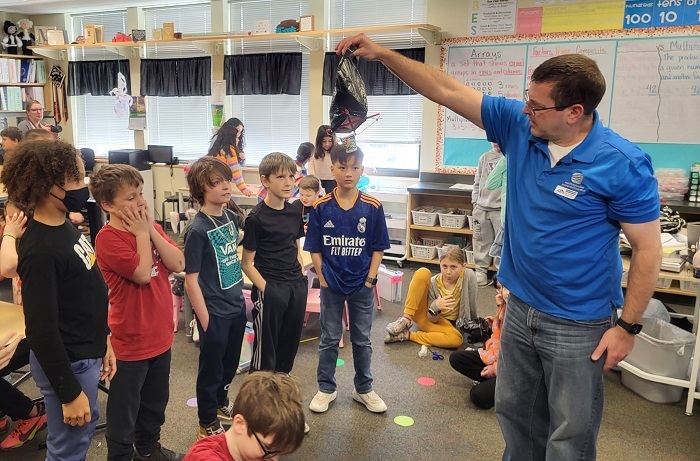 Volunteers from Hanford Site tank operations contractor Washington River Protection Solutions lead fourth-grade students in a STEM-related activity during Hanford Engineers Week.
RICHLAND, Wash. – Engineers from the Hanford Site proved that playing with play dough isn’t only heaps of fun, but it also provides a perfect blend of science, play and learning.
More than 100 Hanford engineers recently volunteered to lead interactive demonstrations about electrical circuits and other activities for elementary and middle school students in southeastern Washington state to increase interest in STEM careers. The science, technology, engineering and math activities included making parachutes and paper gliders, using conductive clay circuits and remotely handling “radioactive” pingpong balls.
“Activities in elementary and middle schools are all hands-on,” said Jeff Dahl, a Bechtel National Inc. engineering group supervisor at the Waste Treatment and Immobilization Plant Project who is on the Hanford Engineers Week committee. “The goal is to proactively reach out to area schools to get kids interested in STEM careers.”
Read a related feature about National Engineers Week. EM Update interviewed four engineers supporting EM across the DOE complex to learn about their careers and contributions to the cleanup mission.
The group of Hanford contractors and other participating organizations included Bechtel, Central Plateau Cleanup Company, Hanford Mission Integration Solutions, Washington River Protection Solutions, Atkins, Hanford Laboratory Management Inc., and Energy Northwest.
The group holds about 200 hands-on interactive sessions each year with over 4,300 students in local elementary, middle and high schools. High school students participate in a friendly competition to solve an engineering-related challenge. In a typical year, about 100 teams participate, with each team of three to four students building a device based on that year’s challenge.
“We need future STEM professionals who will help deliver on our cleanup mission,” said Brian Vance, manager of EM’s Office of River Protection and Richland Operations Office. “You never know if a student’s participation in one of these sessions is what will spur their interest in engineering or science as a career.”
-Contributor: Patti Jones
|